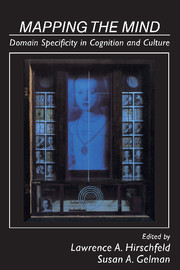Book contents
- Frontmatter
- Contents
- List of contributors
- Preface
- Part I Overview
- Part II The origins of domain knowledge: Biology and evolution
- Part III The origins of domain knowledge: Conceptual approaches
- 5 ToMM, ToBY, and Agency: Core architecture and domain specificity
- 6 Moral belief: Form versus content
- 7 Domain-specific knowledge and conceptual change
- 8 Is the acquisition of social categories based on domain-specific competence or on knowledge transfer?
- 9 The birth and nurturance of concepts by domains: The origins of concepts of living things
- Part IV Are domains theories?
- Part V Domains across cultures and languages
- Part VI Implications for education
- Author index
- Subject index
9 - The birth and nurturance of concepts by domains: The origins of concepts of living things
Published online by Cambridge University Press: 04 August 2010
- Frontmatter
- Contents
- List of contributors
- Preface
- Part I Overview
- Part II The origins of domain knowledge: Biology and evolution
- Part III The origins of domain knowledge: Conceptual approaches
- 5 ToMM, ToBY, and Agency: Core architecture and domain specificity
- 6 Moral belief: Form versus content
- 7 Domain-specific knowledge and conceptual change
- 8 Is the acquisition of social categories based on domain-specific competence or on knowledge transfer?
- 9 The birth and nurturance of concepts by domains: The origins of concepts of living things
- Part IV Are domains theories?
- Part V Domains across cultures and languages
- Part VI Implications for education
- Author index
- Subject index
Summary
The revival of interest in domains of cognition, especially in the contexts of cross-cultural and developmental studies, is a welcome new awareness of how different sorts of concepts and belief systems might become tailored to particular kinds of lawful regularities in our physical and social worlds. To make much progress, however, this new emphasis requires more precise distinctions between types of domains and better descriptions of the ways in which each type might vary across development and cultures. We can talk about domains as rarefied as a cardiologist's knowledge of arrhythmia to those as commonplace as everyday folk psychology. Domains can vary from the highly concrete causally rich relations in a naive mechanics of physical objects to the highly abstract noncausal relations of mathematics or natural language syntax. Lumping together all of these different sorts of domains so as to have similar effects on cognitive development is likely to be misleading and uninformative. In this chapter, I consider some distinctions and their implications for questions concerning the origins of concepts.
The focus of this chapter is on the emergence of biological thought. Concepts of living things may offer an especially clear illustration of how domains might be involved in the origins of more specific concepts, and conversely of how specific concepts become intertwined within larger belief systems. In addition, views of concept structure and use have increasingly invoked the special importance of those belief systems known as theories.
- Type
- Chapter
- Information
- Mapping the MindDomain Specificity in Cognition and Culture, pp. 234 - 254Publisher: Cambridge University PressPrint publication year: 1994
- 146
- Cited by



